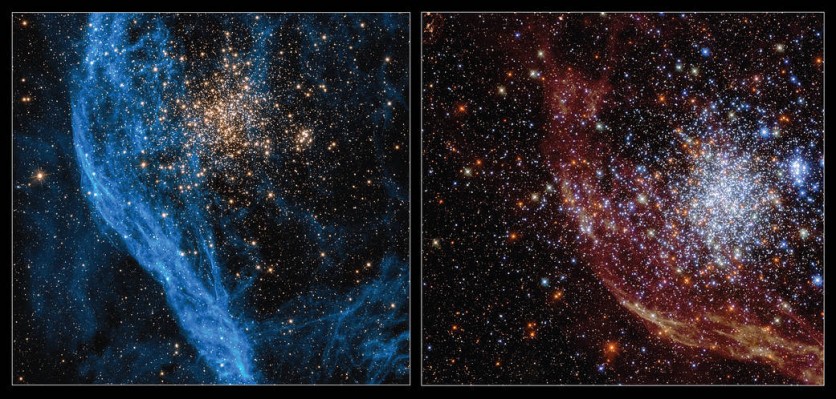Capturing a starry backdrop is always a classic for NASA's Hubble Space Telescope. But why settle for one image when you can have two star-sprinkled images shaded by hues of red and blue?
These photos may look different but they both come from the same cosmic object NGC 1850. Both images were of course captured by the same Hubble instrument, but to examine certain wavelengths of light coming from these objects, separate filters with different assigned colors were employed.

Bright, Starry Images
In contrast to the image with red nebulosity, which covers a much wider range from the near-ultraviolet to the early infrared spectrum, the image with blue nebulosity contains some near-infrared light along with visible light.
As seen in the bright, starry images, ultraviolet measurements are optimal for identifying the light from the hottest and youngest stars, according to NASA.
The Milky Way's satellite galaxy, the Large Magellanic Cloud, which is a habitat to billions of stars, houses this 100 million-year-old globular cluster.
The cluster is located in the constellation Dorado, some 160,000 light-years away. It is a spherical gathering of tightly packed stars bound together by gravitational attraction.
But in contrast to most globular clusters, NASA notes that NGC 1850's stars are still rather young. This makes the cluster unique because there are no other young star-bearing like this in our Milky Way galaxy.
According to astronomers' theories, the initial generation of stars in NGC 1850 expelled gas and dust into the surrounding universe while they were forming.
Due to the freshly created star cluster's extreme density, the ejected matter was unable to escape the cluster's gravitational attraction and remained nearby. The cluster's strong gravity drew in hydrogen and helium gas from its surroundings as well.
Second Generation of Stars
This globular cluster's density and size increased as a result of the interaction between these two gas sources that produced the second generation of stars.
Scientists discovered the black hole in NGC 1850 in 2021. They have also discovered a large number of blue stars, which burn hotter and have a shorter lifespan than red stars.
There are also 200 or so red giant stars, with outer layers that are expanding, cooling, and glowing red because they have run out of hydrogen in their cores and are fusing hydrogen further away from them.
The blue veil-like structures in the first image and the red ones in the second image represent the pattern of nebulosity, diffuse dust, and gas thought to be produced by supernova blasts that surround the cluster.
NGC 1850 has a core that is around 20 light-years across and has a mass that is roughly 63,000 times that of the Sun. To scan this massive star cluster and understand star formation better, astronomers used Hubble Space Telescope data at a variety of wavelengths.
Related Article : NASA's Hubble Space Telescope Captures 'Butterfly Nebula' In Stunning Motion | Fun Facts About This Beautiful Space Butterfly

ⓒ 2025 TECHTIMES.com All rights reserved. Do not reproduce without permission.




